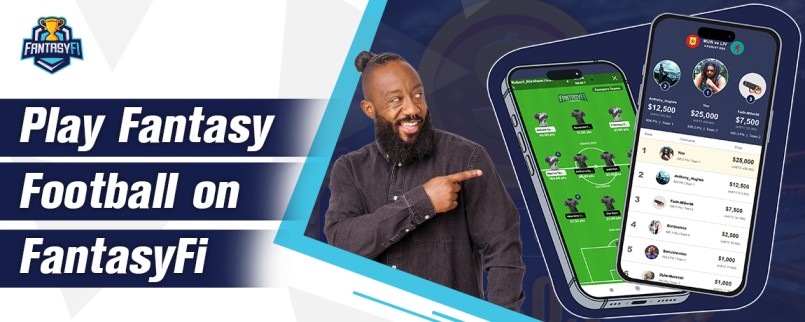Ever watched a match and thought, “I could manage a better team than that?” Fantasy soccer gives you that chance. It’s not just a game, it’s your shot at picking the perfect team, scoring big points, and maybe even beating your friends along the way. Whether you’re new to soccer or fantasy, this guide will walk you through everything you need to know to get started correctly.
Let’s build your first fantasy soccer team together.
What Is Fantasy Soccer?
Fantasy soccer is where you build a team of real players from real soccer leagues, like the English Premier League, La Liga, or Major League Soccer (MLS).
Each week, your players earn points based on their performance in real-life matches. Score a goal? You get points. Keep a clean sheet? More points. Get sent off? Sorry, you lose points.
The goal? Beat other managers by scoring more points over the season.
5 Easy Steps to Start Playing Fantasy Soccer
- Choose a Fantasy Soccer Platform
- Create Your Account and Join a League
- Build Your First Fantasy Squad
- Understand How Fantasy Points Work
- Your Weekly Routine
Step 1: Choose a Fantasy Soccer Platform
Many platforms exist, including FantasyFi, Fantasy Premier League, and more. Each one has different scoring rules, features, and league setups.
Things to consider when picking your platform:
- Can you play with friends in a private league?
- Is the scoring system easy to understand?
- Do they cover your favourite leagues?
If you’re just starting, FantasyFi is beginner-friendly and great for Premier League fans.
Step 2: Create Your Account and Join a League
Signing up is easy. Just enter your email, create a password, and you’re in.
You can:
- Join a public league with random players
- Or create a private league and invite friends (this is where it gets competitive!)
Related post:
- Best Fantasy Football Strategy for 2025
Step 3: Build Your First Fantasy Squad
Once you’re in, you’ll get a virtual budget, use it to pick real-life players for your team. But there’s a catch: You can’t afford everyone. You’ll need to balance expensive stars with hidden gems.
A typical squad includes:
- 2 Goalkeepers
- 5 Defenders
- 5 Midfielders
- 3 Forwards
You’ll select a starting 11 and keep some players on your bench, in case someone gets injured or doesn’t play.
How Each Position Scores Points
| Position | Main Ways to Earn Points |
|---|---|
| Midfielder | Goals, assists, some clean sheet points |
| Goalkeeper | Saves, clean sheets, penalty saves |
| Forward | Goals, assists |
| Defender | Clean sheets, goals, assists |
Not all points are good. Players can lose points for:
- Yellow/red cards
- Own goals
- Missing penalties
- Conceding goals (for defenders and goalkeepers)
Step 4: Understand How Fantasy Points Work
Here’s a quick overview of how points are awarded (varies slightly by platform):
Ways to Gain Points:
- Playing 60+ minutes: 2 points
- Scoring a goal:
- Defender: 6 points
- Midfielder: 5 points
- Forward: 4 points
- Assist: 3 points
- Clean sheet (for defenders and goalkeepers): 4 points
- Goalkeeper saves: 1 point per 3 saves
- Penalty save: 5 points
- Bonus system: Extra points based on overall performance
Ways to Lose Points:
- Yellow card: -1 point
- Red card: -3 points
- Own goal: -2 points
- Penalty missed: -2 points
- Goal conceded (for goalkeepers and defenders): -1 point per 2 goals
Read more:
- How Do Fantasy Points Work? A Guide to Scoring in Fantasy Sports
- Top Fantasy Sites in April 2025 (Ranked by Features, Users & Prizes)
Step 5: Your Weekly Routine (Gameweek to Gameweek)
Every week (called a gameweek), you:
- Pick your starting 11
- Choose a captain (earns double points)
- Make transfers (swap underperforming players)
Keep an eye on:
- Player injuries
- Fixture difficulty
- Weather or match postponements
Don’t set and forget. Fantasy soccer rewards those who stay active.
10 Simple Tips for New Fantasy Managers
- Balance Your Team: Don’t spend all your budget on forwards. You’ll need strong defenders and midfielders too.
- Check the Fixtures: Are your players facing tough opponents or easier ones? Plan transfers accordingly.
- Avoid Taking Too Many Risks Early: It’s tempting to pick only new players or favourites, but proven performers offer stability.
- Be Patient: One bad gameweek doesn’t mean your team is broken. Don’t overreact.
- Choose a Reliable Captain: Pick someone who scores or assists often, not just your favourite player.
- Use Stats + Your Gut: Watch matches, but also look at form, minutes played, and chances created.
- Prioritise Fixing Injuries First: Got an injured or banned player? Replace them before making luxury transfers.
- Wait Before Making Transfers: Don’t rush. Team news usually drops closer to the match. Avoid surprises.
- Don’t Overthink It: If a player is in good form and playing an easy fixture, bring them in.
- Enjoy the Game: Win or lose, remember it’s meant to be fun. Learn as you go.
Fantasy Soccer Glossary: Speak the Lingo
| Term | Meaning |
|---|---|
| Gameweek (GW) | A round of real-life matches where points are earned |
| Differential | A low-owned player who could help you catch up in points |
| Clean Sheet | When a team concedes 0 goals |
| Captain (C) | The player in your team who scores double points that week |
| Transfer | Swapping one player for another |
| Double Gameweek (DGW) | A week where a player has two matches |
| Blank Gameweek | A week where a player’s team has no game |
| Out of Position (OOP) | A player listed as one position but playing another in real life |
| Bench Fodder | Cheap players who rarely play, sitting on your bench |
| Hit | Losing points for making extra transfers beyond the free limit |
Start Playing Fantasy Soccer on FantasyFi Today
If you’re looking for a beginner-friendly platform that allows you to win money daily while playing fantasy soccer, FantasyFi is a great place to begin.
You’ll learn as you play. And who knows? You might just outscore everyone by mid-season. Join FantasyFi here and create your first team today.


